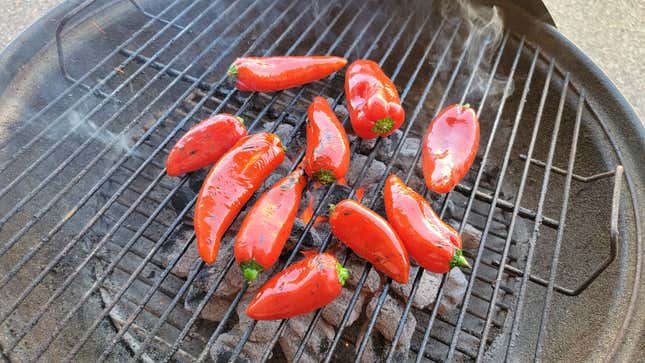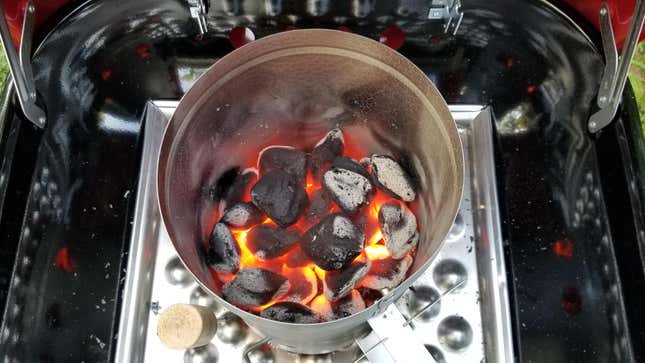
Summer is here, and you can smell it on the wind: the fire, the meats, and the delicious aroma of woodsmoke. Charcoal grilling is a complicated topic for lovers of both good food and the planet it grows on—a planet that is currently beset by North American wildfires. As the skies around me turn hazy, I’ve been wrestling with a difficult environmental question: Is my beloved barbecue contributing to the problem?
Well, yes, yes, and (thank heaven) maybe not, if you’re taking adequate precautions. According to an interview on NPR with one prominent researcher, “The carbon footprint of a gas grill is about one-third the footprint of a charcoal grill.”

Understand the impact of gas vs. charcoal grills
But wait—aren’t lawmakers already embroiled in legislating against gas as a cooking method? Yes, but here we get into the differences between natural gas and propane, the later of which is more often used in grills. As a side note, many articles discussing this topic parrot the same five talking points, but USA Today has a more thoughtful look.
Chemically, charcoal appears to be much simpler. After all, it’s just partially combusted wood. And as for the carbon it releases into the air, Derrick Riches of The Spruce Eats poses an interesting scenario:
“A branch falls from a tree in your yard. You leave it to decay. According to the U.S. Department of Agriculture, the carbon released by this decay is the same as if you burned the wood from the branch. Granted, burning puts that carbon quickly into the atmosphere but the end result is the same.”
The problem, he states, comes when you grind down this same branch, mix it with binders and other flammable materials, form it into briquettes, and douse the whole mess with lighter fluid. But there are other factors to consider, and ways to avoid the added pollutants. Here are a few ways the charcoal lovers among us can do our part to keep our summer grilling on the slightly greener side.

Try natural lump charcoal or sustainably sourced briquettes
While briquettes are more widely available, natural lump charcoal can be found in most home improvement stores. These chunks of charred hardwood burn hotter than their form-pressed contemporaries, though they can heat a bit unevenly due to their irregular size. Still, I’ve found them to be a pleasure to use.
But briquettes aren’t all bad. Take this “All Natural” bag from Royal Oak, for example, “Made in the USA from the finest hardwoods, vegetable starch, and nothing else.” Added binders, chemicals, and the fuel associated with “Match Light” charcoals are what we’re looking to avoid.
There’s also the “sustainability” angle to consider. By using everything from well-managed forests to furniture scraps, charcoal can become a carbon-neutral product. Brands like The Good Charcoal Company make this their focus, but many of the bigger names have started following suit.

Ditch the lighter fluid
The problem here should be obvious: By burning petroleum-based lighter fluid, you’re releasing more petrochemicals into the atmosphere. Plus, if the fluid is improperly applied, the taste of gas can get into your food. If you still enjoy the blossom of fire that comes with a squirt and the drop of a match, trusted brands such as Royal Oak sell “All Natural” lighter fluid options.
Chimney lighters (like this) are great when paired with some crumpled newspaper. It might take a few sheets to get where you’re going, but your patience will be rewarded with some truly wonderful coals. And if newsprint isn’t your thing, many companies sell wood-based kindling pods (like this). Electric charcoal lighters such as these are another option, though this requires proximity to an outlet.

Get as much mileage as possible out of your fire and grill
This tip is all about good resource management. Say you’re only grilling for two. Do you really need to use an entire bag of charcoal? No. Measure out a reasonable amount and save the rest for later. And while you’ve got the fire going, consider making a few extra brats or chicken thighs for the next day. The heat’s already there, so you might as well let the flavors carry into tomorrow.
But you know what does more damage to the environment than a few too many briquettes? The horrible, instantly decaying “bargain” grills you’ll find at dollar stores or Looten Plunder’s Bargain Basement. These last only a season or two before winding up in the trash, especially when left out in the elements (which you shouldn’t be doing in the first place). Instead, invest in a sturdier option.

Keep the grill clean
Many an impressionable young griller has been told to avoid cleaning their grates. “That black gunk is the flavor,” the common expression goes. Well, kinda! But it’s not exactly the flavor you want.
All that buildup actually makes it harder for your grate to come up to heat. You want that surface to get as hot as it can as quickly as possible, and burning through last week’s burgers only hinders the process. And contrary to some folk wisdom, food cooked on a hot surface is less likely to stick than food on an improperly warmed one. Serious Eats has a solid guide on how to keep your grill in good shape, both inside and out.
Let me close with a bit of sympathy. I get it: No grill master likes to be second-guessed or have their methods called into question. But if the recent wildfires and associated air quality issues have taught us anything, it’s that a few changes are called for. Charcoal is an institution, and it doesn’t have to be a thing of the past. With a little product discernment and a few simple, feel-good steps, lovers of live-fire cooking can still enjoy whatever they like grilling best.